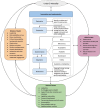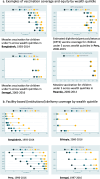Cross-country analysis of contextual factors and implementation strategies in under-5 mortality reduction in six low- and middle-income countries 2000-2015
- PMID: 38413879
- PMCID: PMC10900537
- DOI: 10.1186/s12887-023-03906-5
Cross-country analysis of contextual factors and implementation strategies in under-5 mortality reduction in six low- and middle-income countries 2000-2015
Abstract
Background: The Exemplars in Under-5 Mortality (U5M) was a multiple cases study of how six low- and middle-income countries (LMICs), Bangladesh, Ethiopia, Nepal, Peru, Rwanda, and Senegal, implemented health system-delivered evidence-based interventions (EBIs) to reduce U5M between 2000 and 2015 more effectively than others in their regions or with similar economic growth. Using implementation research, we conducted a cross-country analysis to compare decision-making pathways for how these countries chose, implemented, and adapted strategies for health system-delivered EBIs that mitigated or leveraged contextual factors to improve implementation outcomes in reducing amenable U5M.
Methods: The cross-country analysis was based on the hybrid mixed methods implementation research framework used to inform the country case studies. The framework included a common pathway of Exploration, Preparation, Implementation, Adaptation, and Sustainment (EPIAS). From the existing case studies, we extracted contextual factors which were barriers, facilitators, or determinants of strategic decisions; strategies to implement EBIs; and implementation outcomes including acceptability and coverage. We identified common factors and strategies shared by countries, and individual approaches used by countries reflecting differences in contextual factors and goals.
Results: We found the six countries implemented many of the same EBIs, often using similar strategies with adaptations to local context and disease burden. Common implementation strategies included use of data by decision-makers to identify problems and prioritize EBIs, determine implementation strategies and their adaptation, and measure outcomes; leveraging existing primary healthcare systems; and community and stakeholder engagement. We also found common facilitators included culture of donor and partner coordination and culture and capacity of data use, while common barriers included geography and culture and beliefs. We found evidence for achieving implementation outcomes in many countries and EBIs including acceptability, coverage, equity, and sustainability.
Discussion: We found all six countries used a common pathway to implementation with a number of strategies common across EBIs and countries which contributed to progress, either despite contextual barriers or by leveraging facilitators. The transferable knowledge from this cross-country study can be used by other countries to more effectively implement EBIs known to reduce amenable U5M and contribute to strengthening health system delivery now and in the future.
Keywords: Amenable mortality; Contextual factors; Evidence-based interventions; Implementation research; Implementation strategies; Low- and middle-income countries; Under-5 mortality.
© 2024. The Author(s).
Conflict of interest statement
The authors declare that they have no competing interests.
Figures


Similar articles
-
Inequity in the face of success: understanding geographic and wealth-based equity in success of facility-based delivery for under-5 mortality reduction in six countries.BMC Pediatr. 2024 Feb 28;23(Suppl 1):651. doi: 10.1186/s12887-023-04387-2. BMC Pediatr. 2024. PMID: 38413911 Free PMC article.
-
Understanding rapid implementation from discovery to scale: Rwanda's implementation of rotavirus vaccines and PMTCT in the quest to reduce under-5 mortality.BMC Pediatr. 2024 Feb 28;23(Suppl 1):649. doi: 10.1186/s12887-023-03888-4. BMC Pediatr. 2024. PMID: 38413897 Free PMC article.
-
Integrated Management of Childhood Illness implementation in Nepal: understanding strategies, context, and outcomes.BMC Pediatr. 2024 Feb 28;23(Suppl 1):645. doi: 10.1186/s12887-023-03889-3. BMC Pediatr. 2024. PMID: 38413892 Free PMC article.
-
State of the Science of Scale-Up of Cancer Prevention and Early Detection Interventions in Low- and Middle-Income Countries: A Scoping Review.JCO Glob Oncol. 2024 Jan;10:e2300238. doi: 10.1200/GO.23.00238. JCO Glob Oncol. 2024. PMID: 38237096 Free PMC article.
-
Evidence-based intervention sustainability strategies: a systematic review.Implement Sci. 2019 Jun 6;14(1):57. doi: 10.1186/s13012-019-0910-6. Implement Sci. 2019. PMID: 31171004 Free PMC article.
Cited by
-
Embedded implementation research in programming at scale - the new normal to be!BMC Pediatr. 2024 Feb 28;23(Suppl 1):650. doi: 10.1186/s12887-023-04470-8. BMC Pediatr. 2024. PMID: 38413894 Free PMC article.
-
Using implementation research to understand lessons in reducing child mortality.BMC Pediatr. 2024 Feb 28;23(Suppl 1):654. doi: 10.1186/s12887-023-04472-6. BMC Pediatr. 2024. PMID: 38413965 Free PMC article.
-
Surviving the first five years: the economic and healthcare determinants of child mortality in Sri Lanka.J Health Popul Nutr. 2025 Jun 21;44(1):218. doi: 10.1186/s41043-025-00862-x. J Health Popul Nutr. 2025. PMID: 40544255 Free PMC article.
-
Evidence of health system resilience in primary health care for preventing under-five mortality in Rwanda and Bangladesh: Lessons from an implementation study during the Millennium Development Goal period and the early period of COVID-19.J Glob Health. 2024 Jul 5;14:05023. doi: 10.7189/jogh.14.05023. J Glob Health. 2024. PMID: 38963883 Free PMC article.
References
-
- Ruhago GM, Ngalesoni FN, Norheim OF. Addressing inequity to achieve the maternal and child health millennium development goals: looking beyond averages. BMC Public Health. 2012;12(1) Available from: https://pubmed.ncbi.nlm.nih.gov/23270489/. Cited 2021 Mar 14. - PMC - PubMed
-
- UNICEF DATA. Under-five Mortality. unicef. 2020. Available from: https://data.unicef.org/topic/child-survival/under-five-mortality/. Cited 2021 Feb 25.
MeSH terms
LinkOut - more resources
Full Text Sources
Medical

